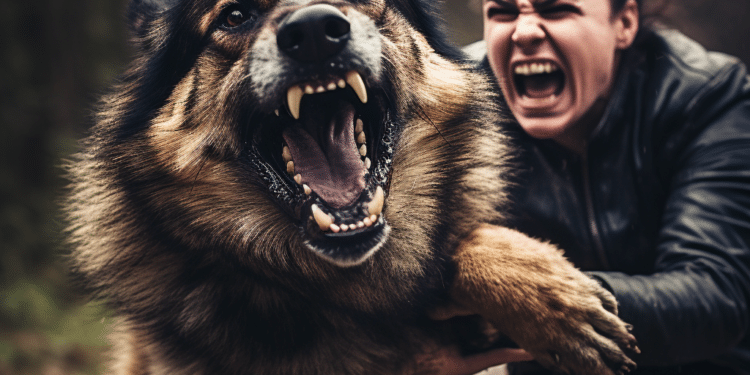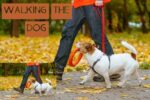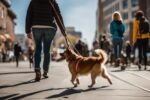How to avoid a dog bite

As a journalist, I’ve seen many cases where a playful interaction with a dog turns into a painful and sometimes dangerous bite. Dog bites are not only painful but can also lead to infections or even tetanus. Therefore, it is essential to learn how to prevent dog bites to stay safe around dogs.
Key Takeaways
- Preventing dog bites requires understanding dog behavior and body language.
- Recognizing warning signs and avoiding risky situations can reduce the likelihood of a dog bite.
- Teaching children about dog safety and properly socializing your dog can also prevent potential bites.
Understanding Dog Behavior
As a responsible dog owner or someone who simply wants to stay safe around dogs, it is essential to understand how dogs behave and communicate. Knowing what a dog is feeling and thinking can help you avoid situations that could lead to a bite.
One of the most important things to keep in mind is that dogs communicate through body language. They use their tails, ears, and posture to show how they are feeling. For example, a dog with a relaxed body posture and a wagging tail is likely happy and friendly. On the other hand, a dog that is stiff, has raised hackles, and is growling or barking is likely feeling threatened or aggressive.
Body Language Cues
Here are some common body language cues to look for when interacting with dogs:
| Body Part | Relaxed | Tense |
|---|---|---|
| Tail | Wagging gently or loosely | Stiff, raised high, or tucked between legs |
| Ears | Relaxed or perked up | Flattened against head or pulled back |
| Mouth | Relaxed, slightly open, or panting | Showing teeth, growling, or snarling |
| Posture | Relaxed, weight evenly distributed | Stiff, leaning forward, or crouching |
It is also important to understand that different breeds and individual dogs may have unique personalities and tendencies. Some breeds may be more prone to aggression or fearfulness, while others are known for their friendly and outgoing nature. That being said, it is always best to approach every dog as an individual and take the time to observe their body language before interacting with them.
By paying attention to a dog’s body language cues, you can avoid potentially dangerous situations and stay safe around dogs. Additionally, teaching children about dog behavior and body language can help reduce the risk of dog bites and promote responsible pet ownership.
- Tip: Never approach a dog that is sleeping, eating, or has a toy or bone. These situations can increase the likelihood of a dog bite.
Recognizing Potential Warning Signs
Being able to recognize potential warning signs is crucial for avoiding dog attacks and staying safe from dog bites. Dogs may display various signs of aggression, discomfort, or fear, which can indicate their inclination to bite or attack.
Some common warning signs of aggression in dogs include:
- Bearing teeth
- Growling or snarling
- Stiff body posture
- Direct eye contact or staring
- Backing away or cowering
- Barking incessantly
- Showing the whites of their eyes
It’s important to note that these signs may not always indicate aggression and can vary depending on the dog and situation. However, it’s essential to approach every dog with caution and be aware of their body language.
Dogs may also display signs of discomfort or fear, such as:
- Tail tucked between their legs
- Whimpering or cowering
- Panting excessively
- Avoiding eye contact or turning their head away
- Fidgeting or trying to escape
If a dog shows any of these signs, it’s essential to give them space and avoid approaching or interacting with them.
Approaching Unknown Dogs Safely
Approaching an unknown dog can be intimidating, especially if the dog appears aggressive or fearful. Here are some tips to keep in mind:
Assess the Situation
Before you approach an unknown dog, take a moment to assess the situation. Look for signs of aggression, such as barking, growling, or baring teeth. If the dog appears calm and relaxed, you can proceed with caution. If the dog seems agitated or scared, it’s best to avoid approaching altogether.
Approach Slowly and Gently
When approaching an unknown dog, do so slowly and gently. Avoid making direct eye contact, as this can be seen as a threat. Instead, approach the dog from the side and allow them to sniff your hand to get a sense of who you are.
Make sure to avoid petting the dog on the head, as this can be seen as a dominant gesture. Instead, pet the dog under the chin or on the chest.
Be Mindful of Body Language
Dogs communicate through body language, so it’s important to be mindful of your own body language when approaching an unknown dog. Avoid making sudden movements or loud noises, as this can startle the dog and trigger aggression. Keep your body relaxed and open, and avoid turning your back on the dog.
Know When to Back Off
If an unknown dog appears agitated or aggressive, it’s best to back off and avoid approaching altogether. If a dog starts to growl or bare their teeth, it’s a clear sign that they are uncomfortable and should be left alone.
Remember, not all dogs are friendly and some may have a history of aggression. It’s important to be cautious when approaching unknown dogs to avoid any potential bites or attacks.
- Avoid approaching unknown dogs that appear agitated or fearful.
- Approach unknown dogs slowly and gently, allowing them to sniff your hand.
- Avoid making sudden movements or loud noises when approaching an unknown dog.
- Pet the dog under the chin or on the chest, avoiding the head.
- Know when to back off and avoid approaching an unknown dog that appears aggressive.
Interacting with Familiar Dogs
Interacting with familiar dogs can be a fun and rewarding experience, but it’s important to remember that even dogs you know well can be unpredictable at times. To ensure your safety and the safety of the dog, follow these dog safety tips and dog bite prevention strategies:
1. Approach with Caution
Even dogs you are familiar with can become aggressive if approached too quickly or inappropriately. Always approach dogs slowly and calmly, avoiding sudden movements that may startle them. Before petting a dog, give them a chance to sniff your hand and get comfortable with your presence.
2. Be Mindful of Body Language
Dogs use body language to communicate their emotions and intentions, and it’s important to pay attention to these cues in order to avoid dog bites. If a dog is growling, showing their teeth, or tucking their tail between their legs, it may be a sign that they are uncomfortable or agitated. Give the dog space and avoid interacting with them until they have calmed down.
3. Avoid Provoking Aggression
Even familiar dogs can become aggressive if they feel threatened or uncomfortable. Avoid playing rough with dogs, pulling on their tails or ears, or engaging in behavior that may provoke aggression. Instead, focus on positive interactions with the dog, such as giving them treats and playing with them in a gentle and respectful manner.
4. Supervise Interactions with Children
Children may not understand how to properly interact with dogs, and may unintentionally provoke aggression. Always supervise interactions between children and dogs, and teach children to approach dogs slowly and calmly. Encourage children to avoid hugging or kissing dogs, and to avoid interacting with dogs while they are eating or sleeping.
By following these dog safety tips and dog bite prevention strategies, you can ensure safe and positive interactions with familiar dogs. Remember to always be respectful of the dog’s boundaries, and to avoid behaviors that may provoke aggression.
Teaching Children About Dog Safety
Preventing dog bites is a crucial aspect of dog safety, especially when it comes to children. As a parent or guardian, it’s essential to teach your child how to interact with dogs in a safe and responsible manner. Here are some dog bite prevention tips you can share with your child:
- Always ask the owner’s permission before petting a dog.
- Approach a dog slowly, from the front, and let them sniff your closed hand.
- Avoid making direct eye contact with the dog, as this can be perceived as a threat.
- Do not approach a dog that is sleeping, eating, or chewing on a toy.
- Teach your child to stand still if a dog approaches them, and to avoid running or screaming.
- If a dog knocks your child down, teach them to curl into a ball, protect their face and neck, and stay still.
- Never pull a dog’s tail, ears, or fur, or climb on or ride a dog.
- Do not disturb a dog while they are using the bathroom.
By teaching children these dog bite prevention tips, you can help ensure their safety around dogs.
Recognizing and Avoiding Risky Situations
Part of staying safe around dogs involves recognizing and avoiding situations that can increase the likelihood of a dog bite. Here are some dog safety tips to minimize the risk:
- Avoid approaching unfamiliar dogs, especially if they are off-leash or in an enclosed area.
- Do not disturb dogs that are sleeping, eating, or caring for puppies.
- Avoid getting between dogs that are fighting or arguing.
- Do not pet a dog without allowing them to sniff and approach you first.
- Be cautious around dogs that are overly excited, aggressive, or fearful.
- Never leave young children alone with a dog, and always supervise their interactions.
By recognizing and avoiding these risky situations, you can help prevent dog bites and ensure a safer environment for both you and your furry friends.
Safeguarding Your Home and Yard
As a dog owner, it’s important to take steps to prevent your dog from biting others. One of the most effective ways to do this is by safeguarding your home and yard. By keeping your dog contained and under control, you can prevent them from attacking or biting others.
Secure Your Fence
A good fence is an essential part of keeping your dog safe and secure. Make sure your fence is sturdy and tall enough to prevent your dog from jumping over it. Check the fence regularly for any damage or areas where your dog could escape.
Properly Train and Socialize Your Dog
Training and socialization are crucial for preventing dog bites. Teach your dog basic commands, such as sit and stay, and make sure they are well-behaved around people and other animals. By socializing your dog from a young age, you can help prevent aggressive behavior.
Keep Your Dog on a Leash
When outside of your home or yard, always keep your dog on a leash. This will allow you to control your dog’s behavior and prevent them from approaching or attacking others.
Supervise Your Dog at All Times
Never leave your dog unattended, especially around children or other animals. Supervision can prevent your dog from behaving aggressively or biting others.
Use Dog Gates and Crates
Dog gates and crates can be useful tools for keeping your dog contained in certain areas of your home. This can prevent your dog from getting into potentially dangerous situations or interacting with strangers.
Conclusion
By taking steps to safeguard your home and yard, you can prevent dog bites and keep your dog and others safe. Proper training, socialization, and supervision are key to preventing aggressive behavior. Remember to always keep your dog under control and take action if you notice any signs of aggression.
Dealing with Aggressive Dogs
Encountering an aggressive dog can be a frightening experience, and it is essential to know how to handle the situation safely. To stay safe from dog bites and avoid aggressive dogs, I recommend following these tips:
- Avoid eye contact: Direct eye contact can be seen as a challenge by dogs, especially aggressive ones. By avoiding eye contact, you can minimize the chances of provoking a dog’s aggressive behavior.
- Stay still: When a dog is approaching you, do not run or make sudden movements. Instead, stay still and wait for the dog to lose interest or back off. Running or moving can trigger the dog’s prey drive, making it more likely to attack.
- Make yourself small: If a dog is growling or baring its teeth, try to make yourself small by crouching or kneeling down. This can make you appear less threatening, reducing the risk of attack.
- Use a barrier: If a dog is charging towards you, try to use a barrier between you and the dog, such as a tree, a car, or a fence. This can create distance and provide protection.
- Back away slowly: If a dog is approaching you, try to back away slowly, facing the dog but not making direct eye contact. Keep your movements slow and controlled, avoiding sudden movements that can trigger the dog’s aggressive behavior.
- Use a deterrent: In extreme cases, you may need to use a deterrent to avoid dog bites. This can include pepper spray, an air horn, or a loud whistle. However, use these deterrents only as a last resort, and only when you feel that your safety is at risk.
Remember, it is important to stay calm and avoid panicking when dealing with aggressive dogs. By following these tips, you can stay safe and avoid potential dog bites.
Properly Socializing Your Dog
One of the most important steps in preventing dog bites is proper socialization of your dog. Socialization involves exposing your dog to various people, places, and situations so that they become comfortable and well-adjusted.
Start socializing your dog at a young age, as early as 7 weeks. This is when puppies are most receptive to new experiences and less likely to develop fear or aggression towards unfamiliar people or dogs.
When socializing your dog, be sure to expose them to a variety of people, including children, adults, men, women, and people of different races and ethnicities. Introduce them to other dogs and animals in a controlled and supervised setting.
It’s important to train your dog to behave appropriately around people and other animals. This includes teaching them basic obedience commands like “sit,” “stay,” and “come.” Positive reinforcement training methods, such as giving treats and praise, can help your dog learn and reinforce good behavior.
When socializing your dog, always prioritize safety. Keep them on a leash or in a securely fenced area to prevent them from running off or getting into dangerous situations. Never force your dog to interact with people or animals if they appear fearful or uncomfortable.
By properly socializing your dog, you can help prevent potential aggression and biting incidents. It’s an important step in ensuring the safety of both your dog and the people and animals around them.
Seeking Professional Help to Prevent Dog Bites
If you are dealing with a dog displaying aggressive behavior, seeking professional help can be crucial in preventing potential bites. In many cases, aggressive behavior can be corrected with proper training and behavior modification.
When seeking professional help, look for a certified dog trainer or behaviorist who specializes in working with aggressive dogs. They can help assess the dog’s behavior and create a tailored training plan to address any issues.
In some cases, medication may also be prescribed to help manage the dog’s behavior. It’s important to follow the trainer or behaviorist’s instructions carefully to ensure the best possible outcome.
If you are unable to afford professional help, consider reaching out to a local animal shelter or rescue organization for assistance. These organizations may be able to provide resources and support to help address any behavioral issues.
Remember, seeking professional help is crucial in addressing aggressive behavior and preventing potential dog bites.
Reporting Dangerous Dogs
If you have encountered an aggressive dog and there is a risk to your safety or the safety of others, it is important to report the dog to local authorities as soon as possible. This can include animal control, the police department, or local government officials. Reporting a dangerous dog is a crucial step in keeping your community safe and preventing future dog attacks.
When reporting a dangerous dog, be sure to provide as much information as possible, including the location of the dog, any identifying information such as the breed or color, and the details of the incident. If you were bitten or attacked by the dog, seek medical attention immediately and report the incident to the authorities.
It is important to remember that not all dogs are aggressive, and reporting a dog out of fear or prejudice can have serious consequences for the dog and its owner. Only report a dog if there is a legitimate concern for safety. If you are unsure whether a dog poses a threat, reach out to a professional for guidance.
By reporting dangerous dogs and working with local authorities, we can all play a role in preventing dog bites and creating safer communities for both humans and dogs.
Remember, being aware of dog safety tips and how to avoid aggressive dogs can go a long way in preventing dog bites. Stay safe and be aware of your surroundings when interacting with dogs.
Conclusion
As a professional copywriting journalist, I understand that dog bites are a serious issue that can lead to physical and emotional trauma, especially for children. It is crucial to understand dog behavior and body language to avoid potential attacks and recognize warning signs of aggression.
Whether interacting with an unknown dog or a familiar one, it is essential to approach them safely and avoid risky situations that can increase the likelihood of a bite. Teaching children about dog safety is also vital to prevent bites, as they are most vulnerable to dog attacks.
If you own a dog, it is essential to socialize them properly and secure your home and yard to prevent potential bites. In case you encounter an aggressive dog, it is crucial to handle the situation safely and seek professional help if necessary. Reporting dangerous dogs to local authorities can also ensure community safety.
Overall, dog bite prevention should be taken seriously, and these tips can significantly reduce the risk of dog bites. Staying safe around dogs is essential for our own and our furry friend’s well-being.
FAQ
Q: How can I avoid a dog bite?
A: To avoid a dog bite, it is important to understand dog behavior and body language, recognize potential warning signs of aggression, approach unknown dogs safely, interact with familiar dogs in a respectful manner, teach children about dog safety, avoid risky situations, safeguard your home and yard, know how to deal with aggressive dogs, properly socialize your dog, seek professional help if needed, and report dangerous dogs to local authorities.
Q: Why is understanding dog behavior important in dog bite prevention?
A: Understanding dog behavior and body language is crucial in avoiding dog bites. It allows you to recognize warning signs of aggression and fear, helping you stay safe and prevent potentially dangerous situations.
Q: How can I recognize potential warning signs of aggression in dogs?
A: Some common warning signs of aggression in dogs include growling, bared teeth, raised fur, stiff body posture, and intense staring. It is important to be able to recognize these signs to avoid potential bites.
Q: What should I do when approaching an unknown dog?
A: When approaching an unknown dog, especially if it appears aggressive or fearful, it is important to proceed with caution. Avoid making direct eye contact, move slowly and calmly, and give the dog space. Always ask the owner for permission before petting the dog.
Q: How can I safely interact with familiar dogs?
A: Interacting with familiar dogs requires understanding their boundaries and preferences. Avoid actions that may provoke aggression, such as pulling their tail or ears. Always approach them calmly and offer your hand for them to sniff before petting.
Q: Why is teaching children about dog safety important?
A: Teaching children about dog safety is crucial to prevent dog bites. They should learn how to approach and interact with dogs respectfully, understand warning signs, and know when to give dogs space.
Q: What are some risky situations to avoid to prevent dog bites?
A: Some risky situations to avoid include approaching dogs that are eating, sleeping, or caring for puppies, as well as disturbing dogs that are showing signs of aggression or fear. It is also important to avoid teasing or provoking dogs.
Q: How can I safeguard my home and yard to prevent dog bites?
A: To prevent dog bites in your home and yard, ensure that your dog is properly contained and cannot escape. Use secure fences and gates, consider using warning signs, and supervise interactions between your dog and visitors or other animals.
Q: How should I handle encounters with aggressive dogs?
A: When faced with an aggressive dog, it is important to stay calm and avoid making sudden movements. Do not run or turn your back on the dog. Instead, back away slowly and try to put a barrier between you and the dog, such as a tree or a car.
Q: Why is proper socialization important in preventing dog bites?
A: Properly socializing your dog from a young age helps them become comfortable and well-adjusted around people and other animals. This decreases the likelihood of aggression and potential bites.
Q: When should I seek professional help for a dog displaying aggressive behavior?
A: If your dog displays aggressive behavior, seeking professional help from a dog trainer or behaviorist is recommended. They can assess the situation, provide guidance, and help you address the underlying causes of the aggression.
Q: When and how should I report dangerous dogs to local authorities?
A: If you encounter a dangerous dog that poses a threat to yourself or others, it is important to report it to local authorities. They can investigate the situation and take necessary action to ensure the safety of the community. Contact your local animal control or law enforcement agency to report the incident.






